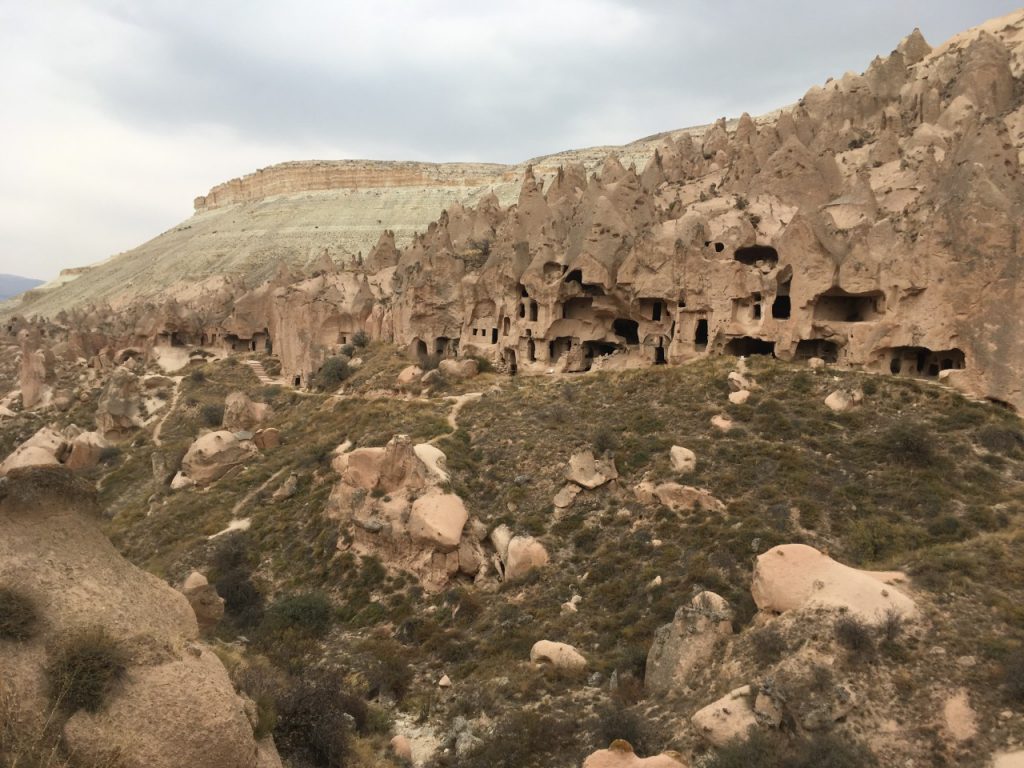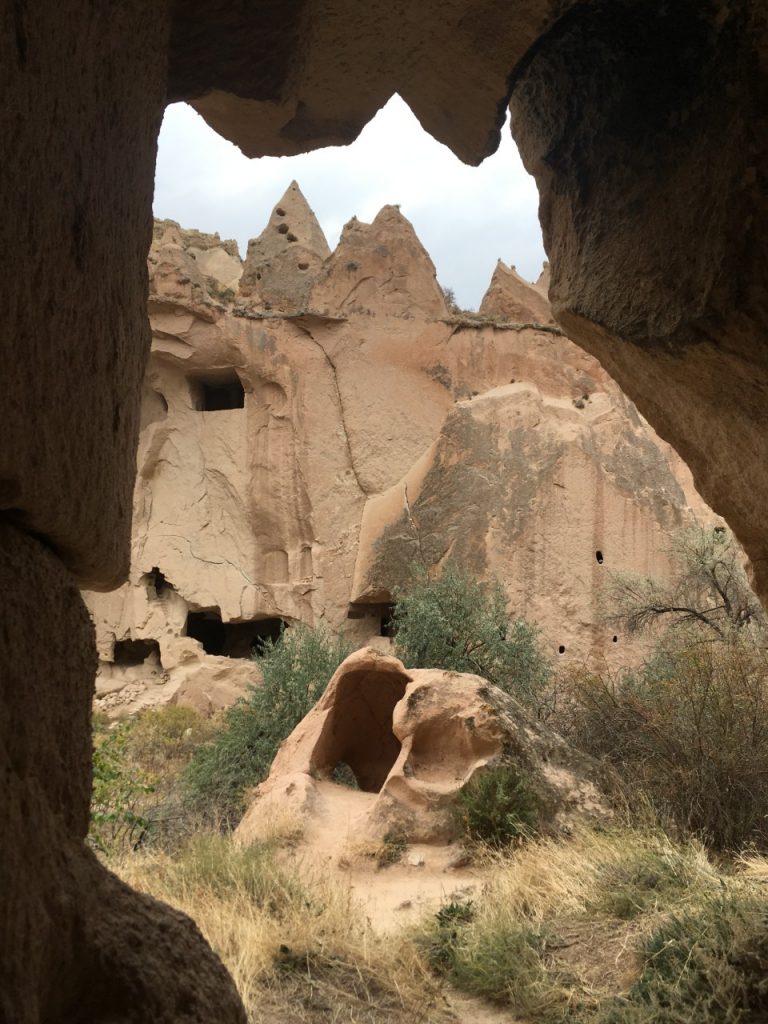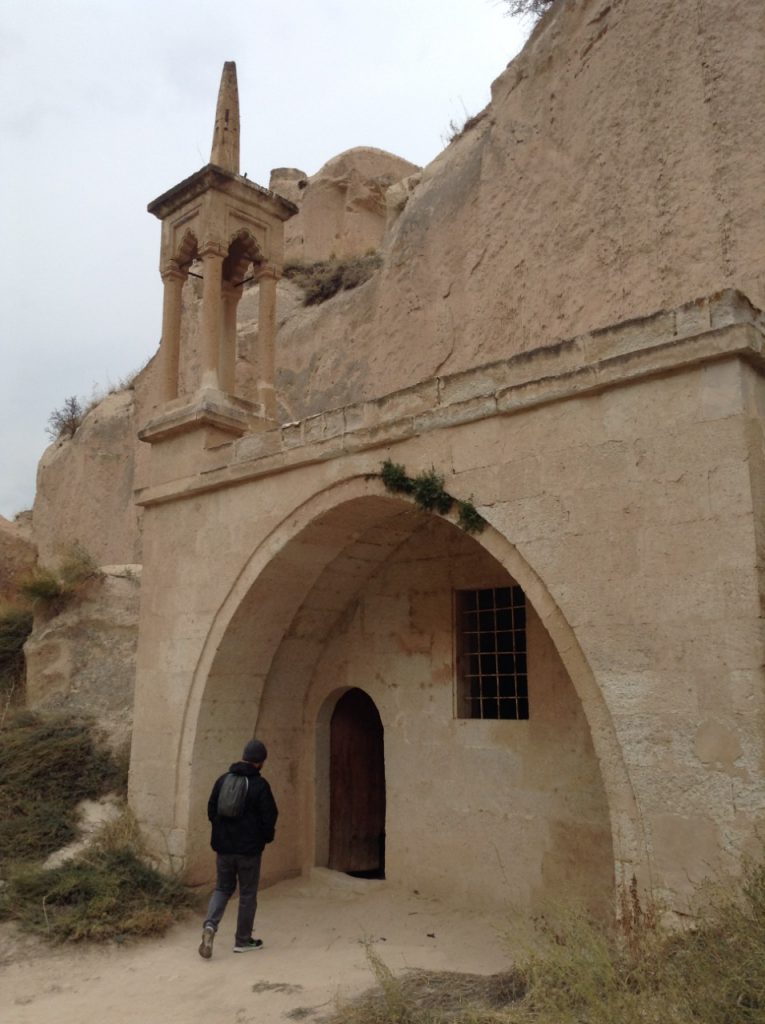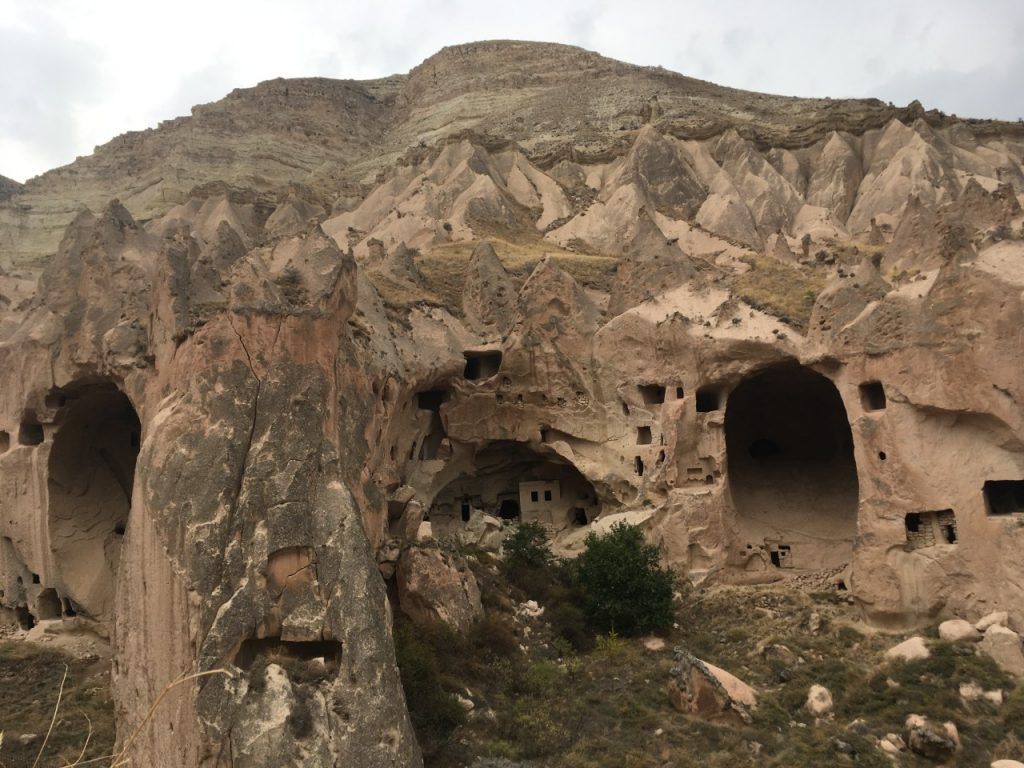The Zelve Valley is an extraordinary landscape located in the Cappadocia Region of Central Anatolia. Dusty, rose-colored spires with knobby crowns balance against a back drop of steep rock cliffs layered with mint green and yellow ochre hues. The soft, muted pastels of the terrain radiate a deep earth energy. Seçkin and I spent an entire day wandering around this lunar landscape. It was early November, a perfect time to explore outdoors since the weather and temperatures were pleasantly comfortable. Although Cappadocia was still brimming with tourists, we were surprised and delighted to find that there weren’t many people at Zelve, today known as the Zelve Open Air Museum. As we began our self-guided tour, I was immediately captivated by the landscape. This is a place that feels like you’re in a dream and I began to wonder if maybe I was. It was hard to believe that this place is real. I began to wonder about the people who had once lived here. What was their life like? What did it feel like to live inside of a cave? These cave dwellers literally lived inside parts of the Earth, connected to nature in a way most people, me included, will most likely not ever experience. In a modern society, the thought of living in a cave is unheard of, but people did live here up until 70 years ago. At one point in history, Zelve did house one of the largest cave communities in Cappadocia so it must have been an alright place to live.

Zelve, Zelve, a lyrical name that rolls off the tongue like a song. An enchanting world of earth, sky and stone. Many of the rock formations, eroded over time, resemble imaginary characters or animal figures. I felt so small walking around and passing through the interiors of these gigantic, archaic structures. Everything looked like a sculpture; the swooping caverns, winding arches, organic shapes and tangible forms of the rocks urged my desire to touch every curve within my reach. Windswept textures built over time, are layered upon the rock face and store memories of days gone by. These incredible textures made my heart sing. Anyone who loves art and geology as much as I do will undoubtedly be awe inspired. Some of the rocks were suspended, they defied gravity by somehow staying intact. There were moments I felt the rocks were trying to communicate somehow. Believe me, I was listening. Some rock formations along the trail are hollow so I didn’t hesitate and climbed right into the belly of a stoic earth spirit. The rocks seemed very much alive, constantly shape shifting over time, transforming, becoming something new.

Historically, Zelve was a place where monks once lived, a monastery retreat. They worshiped in the caves, made wine and stored their food in natural dry storage deposits. Imagine what it must have been like to live hidden away from the world, hanging out with a bunch of like-minded people and drink wine until your hearts content. They also kept livestock in cave stables and raised pigeons for their fertilizer. The pigeons lived in güvercinlik, dove-cotes (pigeon loft) located high above the cave homes and carved into the facades of the rock. Local artists hand painted decorative motifs using natural pigments around the entrance. Floral and kilim motifs were among the most popular designs. I couldn’t get enough of these bedazzled pigeon houses. We continued to make our way through countless passages and every room was more exciting than the last. During history, there was a time when Muslims and Christians lived here together, peacefully, up until 1924 when the Christians were forced to leave the valley due to the exchange of minorities between Greece and Turkey. Eventually, the remaining residents were also forced to evacuate the valley during the early 1950’s due to the high-risk dangers caused by erosion in the caves. The villagers then relocated and established a new settlement nearby called Yeni Zelve or New Zelve. Gone are the days when the villagers rose to greet the sun rising over the jagged peaks of their hometown. Now, only the pigeons remain, carrying with them the stories of the people who once looked after them. Alas, this magical place carries on despite the erosion.

Zelve spans over three valleys and each one is packed with fascinating sights. In the first valley, we discovered a rock cut mosque with a charming minaret. The interior was in excellent condition. Just around the corner, we ventured through a monastery complex. I peeked out of the windows and wondered how it must have felt to see this dramatic view every day. Amazing. We continued on our journey and followed the path in front of the mosque that lead us to the second valley. Here, we discovered numerous cave homes and endless nooks and crannies. The Third valley is home to the remains of two churches: Üzumlü Kilise (the church with the grapes) and Balık Kilise (the church with the fish). This is also where the town square was once active and festivals were celebrated.

After climbing around and taking in all those magnificent sights, we were hungry. Just outside of the museum, there are several restaurants to choose from and all claim to have the best gözleme (Turkish style crepes). We did eat the best gözleme we had ever had and my husband is Turkish, so that says a lot. Maybe it had to do with the super fresh ingredients, but I’m convinced it was the skilled hand of the teyze who cooked it to perfection. We sat outside on the terrace and inhaled our lunch washing it all down with a couple glasses of çay. Slowly, I began to process what I had just experienced. A magical terrain saturated with history and untold stories. Zelve left me awestruck and inspired. This land of enchantment is a definite must see on a trip to Cappadoccia.
Images courtesy of the author. You can find the first edition of Anatolian Travel Archives here.









